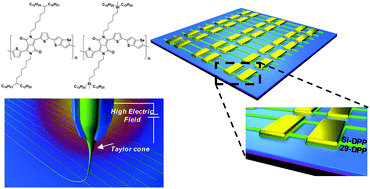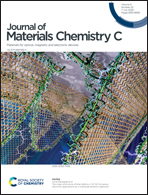A novel design of donor–acceptor polymer semiconductors for printed electronics: application to transistors and gas sensors†
Abstract
Jet printing of π-conjugated polymers synthesized through simple solution processes has been considered to be promising for the direct patterning of organic semiconductors on large-area substrates. However, it is still challenging to achieve direct patterns of high-performance polymer semiconductors through electrohydrodynamic jet printing because of the relatively low solubilities of donor–acceptor π-conjugated polymers which have high charge carrier mobilities and operation stabilities. A novel synthesis is proposed to obtain donor–acceptor π-conjugated polymer semiconductors suitable for printed electronics while exhibiting high performance of hole transport properties. The backbones and side chains of the donor–acceptor π-conjugated polymers are fully engineered to (1) achieve balanced jetting conditions and (2) provide time to induce the intermolecular self-assembly during the continuous printing. The printed polymers have similar morphologies and molecular orderings to those of spin-coated semiconductor films, which provide highly uniform electrical performances of organic field-effect transistors (OFETs) with a saturation mobility similar to those of the spin-coated films, up to 3.07 cm2 V−1 s−1. Furthermore, these high performances and operational stabilities suggest feasibility of the printed OFETs to be applied to ammonia gas sensors. Our study guides the design of π-conjugated polymers suitable for large-area printing processes to contribute to printed electronics.



 Please wait while we load your content...
Please wait while we load your content...